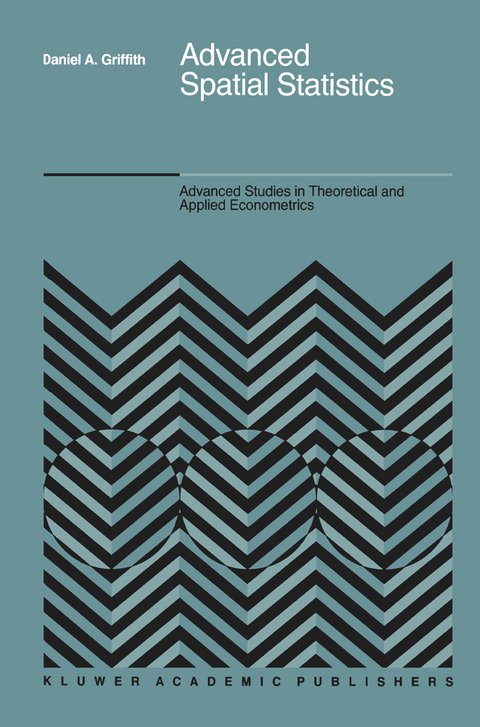
Advanced Spatial Statistics
Springer (Verlag)
978-94-010-7739-2 (ISBN)
1. Introduction to spatial statistics and data handling.- 1.1. A brief historical background.- 1.2. The principal problem of spatial statistics.- 1.3. Spatial sampling perspectives.- 1.4. Models of spatial autocorrelation.- 1.5. Towards a theory of spatial statistics.- 1.6 References.- Appendix 1A: Derivation of the expected value of MC.- Appendix 1B: Derivation of the expected value of GR.- 2. Developing a theory of spatial statistics.- 2.1. The small sample size problem.- 2.2. Finite versus infinite surfaces.- 2.3. Data transformations.- 2.4. Multivariate analysis.- 2.5. Higher order autoregressive models.- 2.6. Concluding comments.- 2.7. References.- 3. Areal unit configuration and locational information.- 3.1. Planar tessellations.- 3.2. Eigenfunction analysis of areal unit configuration tessellations.- 3.3. Selected applications of the principal eigenfunctions of matrix C.- 3.4. The modifiable areal unit problem.- 3.5. The importance of configurational information: a case study of Toronto.- 3.6. Implications.- 3.7. References.- 4. Reformulating classical linear statistical models.- 4.1. Autocorrelated errors models.- 4.2. Autocorrelated bivariate models.- 4.3. A spatially adjusted ANOVA model.- 4.4. The two-groups discriminant function model.- 4.5. Hypothesis testing and spatial dependence.- 4.6. Efficiency of spatial statistics estimators.- 4.7. Consistency of spatial statistics estimators.- 4.8. Conclusions.- 4.9. References.- 5. Spatial autocorrelation and spectral analysis.- 5.1. A brief background for spectral analysis.- 5.2. Relationships between autoregressive and spectral models.- 5.3. Defining the covariance matrix of a conditional spatial model using the spectral density function.- 5.4. Spectral analysis and two-dimensional shape measurement.- 5.5. Concluding comments.- 5.6. References.- 6. The missing data problem of a two-dimensional surface.- 6.1. The incomplete data problem statement.- 6.2. Background.- 6.3. Solutions available in commercial statistical packages.- 6.4. The spatial data problem.- 6.5. Properties of the conditional model when data are incomplete.- 6.6. An algorithm for the conditional spatial case.- 6.7. Constrained MLEs.- 6.8. Concluding comments.- 6.9. References.- Appendix 6A: FORTRAN subroutine.- 7. Correcting for edge effects in spatial statistical analyses.- 7.1. Problem statement.- 7.2. Major proposed solutions.- 7.3. An evaluation of the major proposed solutions.- 7.4. Conclusions and implications.- 7.5. References.- 8. Multivariate models of spatial dependence.- 8.1. A multivariate normal probability density function with spatial autocorrelation.- 8.2. Discerning latent structure in multivariate spatial data.- 8.3. Estimation problems.- 8.4. Selected empirical examples.- 8.5. Extensions to multivariate models in general.- 8.6. Concluding comments.- 8.7. References.- Appendix 8A: Rules for Kronecker products.- 9: Simulation experimentation in spatial analysis.- 9.1. Testing a null hypothesis of zero spatial autocorrelation.- 9.2. Generating autocorrelated pseudo-random numbers for two-dimensional surfaces.- 9.3. Background.- 9.4. Quality of the pseudo-random numbers.- 9.5. Variance reduction techniques.- 9.6. Selecting the number of replications r.- 9.7. Analysis of the simulation results for Chapter 6.- 9.8. Concluding comments.- 9.9. References.- 10. Summary and conclusions.- 10.1. Summary.- 10.2 Conclusions.- 10.3 References.
| Reihe/Serie | Advanced Studies in Theoretical and Applied Econometrics ; 12 |
|---|---|
| Zusatzinfo | XIV, 274 p. |
| Verlagsort | Dordrecht |
| Sprache | englisch |
| Maße | 155 x 235 mm |
| Themenwelt | Mathematik / Informatik ► Mathematik ► Statistik |
| Wirtschaft ► Allgemeines / Lexika | |
| Wirtschaft ► Volkswirtschaftslehre ► Ökonometrie | |
| ISBN-10 | 94-010-7739-8 / 9401077398 |
| ISBN-13 | 978-94-010-7739-2 / 9789401077392 |
| Zustand | Neuware |
| Haben Sie eine Frage zum Produkt? |
aus dem Bereich


